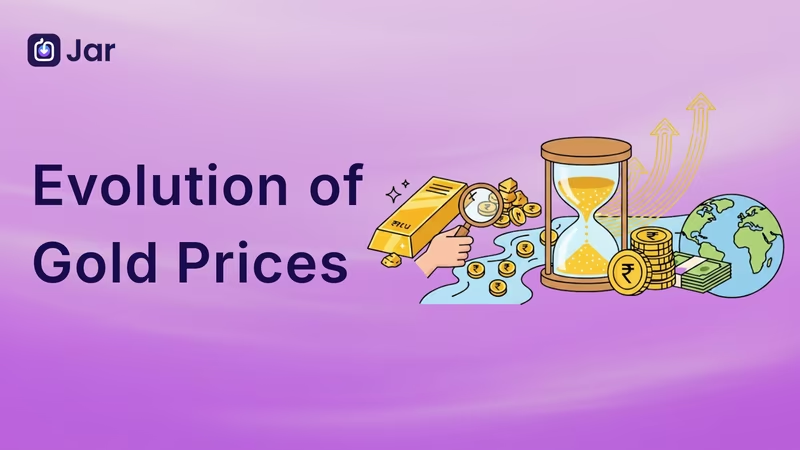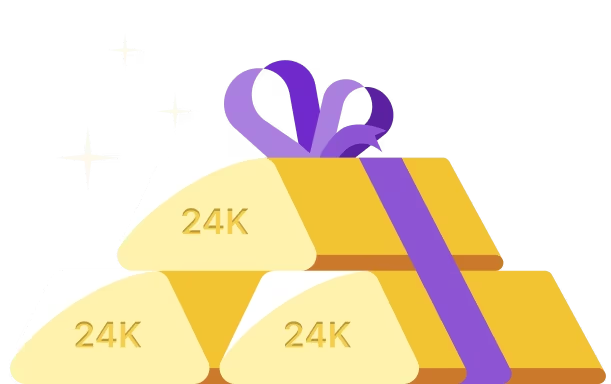The evolution of gold prices is one of the most significant narratives in the global economy.
It is not just a record of numbers; it is a timeline of wars, recessions, pandemics, and human resilience.
For investors and families alike, the gold price chart serves as a financial history book, showing how the "yellow metal" has consistently defeated inflation over the last century.
If you are tracking the gold price trend or wondering if this is the right time to invest, this guide covers everything from A Brief History of Gold to the hidden taxes that affect the gold rate today.
A Brief History of Gold: Who Discovered It?
Before diving into the rates, we must answer a fundamental question: who discovered gold and which year?
Unlike modern currency, gold was never "invented." It was discovered by early humans, likely in its natural, glittering state in riverbeds.
- When did gold was discovered? The earliest evidence of gold processing dates back to 4,600 BC at the Varna Necropolis in Bulgaria.
- The First Money: While no single person can claim the discovery, the Kingdom of Lydia (modern-day Turkey) is credited with striking the first gold coins around 600 BC, officially birthing the concept of the gold price.
Why Is Gold So Precious?
Have you ever asked yourself, why is gold so precious? It isn’t just because it looks good in a wedding necklace.
- Indestructibility: Gold is chemically inert. It does not rust or tarnish. A coin from 1950 looks the same today.
- Scarcity: It is rare enough to be valuable but available enough to trade.
- The "Fear" Factor: When stock markets crash or governments print too much money, investors rush to gold, driving up the gold rate.
Gold Price Chart: The Complete History Of Gold
Below is the detailed gold price year wise data. This table traces the journey of 10 grams of gold.
| Year | Price (₹ per 10g) | Growth (%) |
| 2025 | ₹127,200 | 63.26% |
| 2024 | ₹77,913 | 19.26% |
| 2023 | ₹65,330 | 24.04% |
| 2022 | ₹52,670 | 8.11% |
| 2021 | ₹48,720 | 0.14% |
| 2020 | ₹48,651 | 38.13% |
| 2019 | ₹35,220 | 12.03% |
| 2018 | ₹31,438 | 5.97% |
| 2017 | ₹29,667 | 3.65% |
| 2016 | ₹28,623 | 8.66% |
| 2015 | ₹26,343 | -5.94% |
| 2014 | ₹28,006 | -5.39% |
| 2013 | ₹29,600 | -4.67% |
| 2012 | ₹31,050 | 17.61% |
| 2011 | ₹26,400 | 42.70% |
| 2010 | ₹18,500 | 27.59% |
| 2009 | ₹14,500 | 16.00% |
| 2008 | ₹12,500 | 15.74% |
| 2007 | ₹10,800 | 54.29% |
| 2005 | ₹7,000 | 59.09% |
| 2000 | ₹4,400 | -5.98% |
| 1995 | ₹4,680 | 46.25% |
| 1990 | ₹3,200 | 50.23% |
| 1985 | ₹2,130 | 60.15% |
| 1980 | ₹1,330 | 146.30% |
| 1975 | ₹540 | 193.48% |
| 1970 | ₹184 | 190.91% |
| 1964 | ₹63.25 | -36.11% |
| 1950 | ₹99.00 | - |
Note on the Gold Rate Graph: If you visualize this data, you will see a "hockey stick" curve. Prices remained flat for 50 years, then exploded after 2005 due to global money printing.
Gold Price Evolution (1950–2025)
Visualizing the historical price of 10 grams of 24k gold in India.
What If I Had Invested In Gold Calculator
You have seen the history. You have seen how ₹63 in 1964 turned into ₹1,27,200 in 2025. The lesson from the gold price chart is clear: waiting usually means paying a higher price later.
Many people think they need thousands of rupees to buy gold, but that is no longer true.
Start Buying Digital Gold with Jar You don't need to wait for a wedding or a bonus to start Buying. With Jar, you can automatically save small amounts, even your spare change and convert it into 24 Carat Digital Gold instantly.
Why the Gold Rate Today is Increasing
You might notice that the gold rate today is significantly higher than it was just a few years ago. Why does the gold price trend keep pointing up?
1. The "Safe Haven" Effect
Whenever there is bad news in the world war, pandemics, or political instability investors sell risky stocks and buy gold. This sudden demand spikes the gold rate.
2. Currency Fluctuation
In India, gold is imported using US dollars. When the rupee weakens against the dollar, the gold price in India rises, even if the international market is stable.
3. Marriage Season & Demand
In India, the 22 carat gold rate today is often driven by local demand. During wedding seasons (Diwali, Akshaya Tritiya), millions of families buying jewelry can push the 22kt gold rate higher than the global average.
Understanding Purity: 24k vs 22k vs 18k
When checking the gold price today, it is critical to know which "karat" you are looking at, as the price difference is massive.
24 Carat Gold Price (The Investment Standard)
This is 99.9% pure gold. It is soft and malleable. If you see the 24 k gold rate today reaching record highs, this refers to gold bars and coins. It is not for jewelry.
22 Carat Gold Rate (The Jewelry Standard)
This is 91.6% gold mixed with metals like copper, zinc, or silver to make it hard enough to wear. The 22 kt gold rate today will always be lower than 24k.
(Tip: This is often referred to as "916 Gold" in shops).
1 Gram Gold Price
Many investors now buy gold in small quantities. Tracking the 1 gram gold price is the best way to start a Systematic Investment Plan (SIP) in gold.
The Hidden Costs: GST and Making Charges Of Gold
Many buyers look at the gold rate graph online and are surprised when the final bill at the jeweler is higher. This is due to two factors that most blogs don't mention.
Making Charges
This is the fee for the labor involved in designing the jewelry. It can range from 8% to 25% depending on the intricacy of the design.
GST (Goods and Services Tax):
- 3% GST is applied to the value of the gold.
- 5% GST is applied to the making charges.
Example: If the gold price last 10 days averaged ₹70,000, your final bill for 10 g of jewelry could easily be ₹80,000+ after adding these costs.
Beyond Gold: The Silver (Chandi) Connection
Smart investors don't just watch gold. The chandi rate today (Silver) is often more volatile but can offer higher percentage returns.
Silver is heavily used in EV batteries and solar panels, meaning its price is driven by industrial demand, unlike gold which is driven by investment demand.
Quickly estimate the value of your gold with an easy, accurate calculator that helps you make smarter buying or selling decisions.
Future Prediction: Where Is Gold Heading?
Looking at the gold price for the last 10 days might show short-term volatility, but the long-term gold price trend is clear.
With 2025 prices touching ₹1,27,200, financial experts predict that as long as global inflation remains high, gold will continue to protect wealth.
Whether you are tracking the 24 carat gold rate today for a digital gold investment or the 22kt gold rate for a family wedding, history tells us one thing: Paper currency loses value over time, but gold preserves it.
FAQs
What was the gold price 10 years ago?
In November 2015, the gold price in India was relatively affordable, trading between ₹25,000 and ₹26,500 per 10 grams for 24K purity.
This period marked a phase of consolidation where gold prices were stabilizing after the post-2008 financial crisis rally, driven by a strengthening US Dollar and lower global inflation expectations at the time.
What is the 5-year return of gold?
Gold has delivered a stellar performance over the last half-decade, offering an absolute return of approximately 150%.
In November 2020, gold prices hovered around ₹48,600 to ₹50,000, while in November 2025, they have surged to over ₹1,25,000 per 10 grams; this translates to a compounded annual growth rate (CAGR) of nearly 20%, significantly outperforming inflation and many fixed-income instruments.
What is the highest price of gold in history?
As of November 2025, gold recently hit its all-time historical high, reaching approximately ₹1,28,910 per 10 grams in the Indian domestic market and crossing $4,380 per ounce in international markets.
These record-breaking levels have been fueled by central bank buying, heightened geopolitical tensions, and a depreciating Rupee, marking a historic peak for the yellow metal.
Will Gold prices rise or fall?
The broader market sentiment remains bullish (rising) for the long term, though short-term volatility is expected.
While prices may see temporary corrections due to fluctuations in the US Dollar or Federal Reserve policy announcements, analysts predict an upward trajectory driven by continued global uncertainty and de-dollarization efforts, with support levels remaining strong around ₹1,20,000.
Will gold touch 2 lakh?
While hitting ₹2,00,000 per 10 grams is an aggressive target, many financial analysts project that gold could approach the ₹1.6 Lakh to ₹1.95 Lakh range by 2029-2030 if current growth rates continue.
For the price to touch ₹2 Lakh specifically, we would likely need to see a combination of severe sustained global inflation and a continued sharp depreciation of the Indian Rupee against the Dollar over the next 5 to 7 years.
Is it wise to buy gold in 2025?
Yes, financial experts generally consider it wise to maintain exposure to gold in 2025 as a hedge against inflation and market volatility, though a "buy on dips" strategy is recommended given the current record highs.
Instead of lump-sum purchases, opting for Sovereign Gold Bonds (SGBs) or Gold ETFs is often advised for better liquidity and tax efficiency, ensuring you benefit from long-term appreciation without the hassles of storage or making charges.










